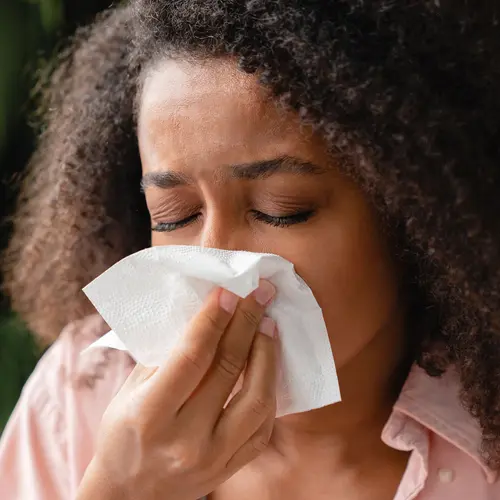What Is Cholinergic Urticaria?
Cholinergic urticaria (also called cholinergic angioedema or heat bumps) is a reaction that results in tiny hives surrounded by large patches of red skin. They’re related to an increase in your body temperature. You can get itchy red hives on your skin for lots of reasons. The ones that break out when you're sweaty from a workout, nervous, or just hot are called cholinergic urticaria (CU).
It's not clear what causes this condition. Some evidence suggests it may be due to the nervous system or from an allergic response to sweat.
You may be more likely to get these hives if you have eczema, asthma, or other allergies like hay fever, or if you get hives for other reasons, such as from certain foods or medications, pressure on your skin, or cold weather. Anyone can get cholinergic urticaria.
Some people with CU have only a mild case of the condition; but others can get a serious or life-threatening version of the disease. Signs and symptoms of a serious case of CU include:
Hives all over your body (generalized urticaria)
Swelling in the deeper layers of the skin (angioedema) often around the face and lips. If swelling causes your throat or tongue to block your airway, this can be life-threatening.
Bronchospasm. Your airways go into spasm and contract abnormally, making it difficult to breathe. You can also have wheezing or coughing.
Low blood pressure (hypotension). Very low blood pressure can be life-threatening.
Cholinergic Urticaria Symptoms
These hives are itchy, tingly, and warm. They're usually small (1-3 millimeter) red bumps with flares or circles around them called wheals.
You can get them anywhere on your body, but most of the time they show up on your chest, face, upper back, and arms. Sometimes, the bumps are close together. Your skin can look swollen and blotchy, or you may just look flushed.
CU hives pop up within 6 minutes of contact with a trigger. They last about 30 minutes to an hour or two before they fade away.
It's not common, but you also may have one or more of these along with hives:
Exercise-induced anaphylaxis
Although it’s very rare, some people can get anaphylaxis (a serious allergic reaction) from doing active exercise like aerobics and jogging, or even less intense activity like walking. Symptoms of exercise-induced anaphylaxis are:
Skin reactions, like hives, itching, flushed or pale skin
Low blood pressure (hypotension)
Weak and rapid pulse
Airway constriction -- sometimes with swollen tongue or throat, which can cause wheezing and difficulty breathing
Dizziness or fainting
Nausea, vomiting, or diarrhea
If you notice a skin reaction after exercise, look out for these other warning signs. If you or someone you are with has them, call 911.
Cholinergic Urticaria Causes and Risk Factors
CU is caused by nerve fibers in your sweat glands. Your skin reacts to the heat and sweat when your body temperature goes up.
You may get these hives when you:
Take a hot shower or bath
Work up a sweat from exercise
Are in a hot climate
Wear a tight, clingy bandage
Get nervous, have anxiety, or start to sweat
Eat hot or spicy foods
Are upset or angry
Cholinergic Urticaria Diagnosis
If you notice that your skin gets itchy, red, and blotchy when you're hot or you're a few minutes into a workout, see your doctor. A dermatologist (skin specialist) or allergist can also diagnose CU. In order to diagnose it:
Your doctor will ask you what your hives look like when you get them and how long they last to rule out other causes, such as foods you eat.
They may ask you to run or ride a stationary bike for about 15 minutes to see whether you break out as you sweat.
They may give you a shot of methacholine, a medicine that shrinks your airways, to make the bumps show up.
Cholinergic Urticaria Treatment
If you live in a hot climate or like to exercise, it can be hard to stay away from the heat that causes these hives.
These antihistamines, used to treat allergies, may help control them:
Cetirizine (Zyrtec)
Diphenhydramine (Benadryl)
Fexofenadine (Allegra)
Loratadine (Alavert, Claritin)
If antihistamines don't work, your doctor may recommend steroids for a short time or histamine 2 receptor blockers such as Zantac or Tagamet. All antihistamines are more effective if taken daily rather than on an as-needed basis.
Other treatments for CU include leukotriene inhibitors (Singulair), immunosuppressives (cyclosporine, dapsone), Danazol, beta-blockers (propranolol), topical scopolamine, and omalizumab (Xolair).
If you have serious reactions -- like shortness of breath -- when you get hives, your doctor might give you an epinephrine shot for you to keep on hand. This can help your breathing and get rid of hives and swelling.
Cholinergic Urticaria Prevention
Stop or slow down your workouts if you break out in hives. If some types of exercise make you break out more often, try other activities instead.
Cool your hot skin to prevent or ease hives:
Try a cool shower, press a cloth soaked in cool water to your skin, or stand in front of a fan.
Wear loose clothes.
Keep your home and bedroom at a cool temperature.
If stress causes your hives, try to avoid situations that upset you. Find ways to calm down and manage it.

